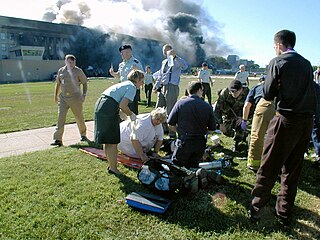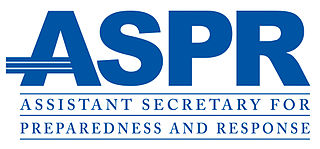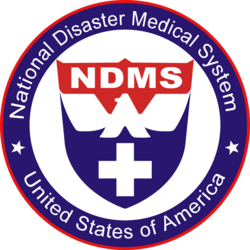
The United States Department of Health and Human Services (HHS) is a cabinet-level executive branch department of the U.S. federal government created to protect the health of the U.S. people and providing essential human services. Its motto is "Improving the health, safety, and well-being of America". Before the separate federal Department of Education was created in 1979, it was called the Department of Health, Education, and Welfare (HEW).

The Federal Emergency Management Agency (FEMA) is an agency of the United States Department of Homeland Security (DHS), initially created under President Jimmy Carter by Presidential Reorganization Plan No. 3 of 1978 and implemented by two Executive Orders on April 1, 1979. The agency's primary purpose is to coordinate the response to a disaster that has occurred in the United States and that overwhelms the resources of local and state authorities. The governor of the state in which the disaster occurs must declare a state of emergency and formally request from the President that FEMA and the federal government respond to the disaster. The only exception to the state's gubernatorial declaration requirement occurs when an emergency or disaster takes place on federal property or to a federal asset—for example, the 1995 bombing of the Alfred P. Murrah Federal Building in Oklahoma City, Oklahoma, or the Space Shuttle Columbia in the 2003 return-flight disaster.
The Strategic National Stockpile (SNS), originally called the National Pharmaceutical Stockpile (NPS), is the United States' national repository of antibiotics, vaccines, chemical antidotes, antitoxins, and other critical medical supplies. Its website states:
"The Strategic National Stockpile's role is to supplement state and local supplies during public health emergencies. Many states have products stockpiled, as well. The supplies, medicines, and devices for life-saving care contained in the stockpile can be used as a short-term stopgap buffer when the immediate supply of adequate amounts of these materials may not be immediately available."

The Medical Reserve Corps (MRC) is a network in the U.S. of community-based units initiated and established by local organizations aimed to meet the public health needs of their communities. It is sponsored by the Administration for Strategic Preparedness and Response (ASPR) of the United States Department of Health and Human Services (HHS). The MRC consists of medical and non-medical volunteers who contribute to local health initiatives, such as activities meeting the Surgeon General's priorities for public health, and supplement existing response capabilities in time of emergency. The MRC provides the structure necessary to pre-identify, credential, train, and activate medical and public health volunteers.

A disaster medical assistance team (DMAT) is a group of professional medical personnel organized to provide rapid-response medical care or casualty decontamination during a terrorist attack, natural disaster, or other incident in the United States.

Rear Admiral W. Craig Vanderwagen USPHS - retired is a Founder and General Manager of East West Protection, LLC. EWP provides disaster preparedness policy and program development, management, strategic planning advice, training management, and threat and impact studies and analytical support to local, national and international organizations in both the public and private sectors.
A Disaster Mortuary Operational Response Team or DMORT is a team of experts in the fields of disaster victim identification and mortuary services. DMORTs are activated in response to large scale disasters in the United States to assist in the identification of deceased individuals and storage of the bodies pending the bodies being claimed.

Signed into effect on 12 June 2002, the Public Health Security and Bioterrorism Preparedness and Response Act of 2002 (PHSBPRA) was signed by the President, the Department of Health and Human Services (DHHS) and the U.S. Department of Agriculture (USDA).
In the United States, the hospital incident command system (HICS) is an incident command system (ICS) designed for hospitals and intended for use in both emergency and non-emergency situations. It provides hospitals of all sizes with tools needed to advance their emergency preparedness and response capability—both individually and as members of the broader response community.

Disaster medicine is the area of medical specialization serving the dual areas of providing health care to disaster survivors and providing medically related disaster preparation, disaster planning, disaster response and disaster recovery leadership throughout the disaster life cycle. Disaster medicine specialists provide insight, guidance and expertise on the principles and practice of medicine both in the disaster impact area and healthcare evacuation receiving facilities to emergency management professionals, hospitals, healthcare facilities, communities and governments. The disaster medicine specialist is the liaison between and partner to the medical contingency planner, the emergency management professional, the incident command system, government and policy makers.
The United States National Response Framework (NRF) is part of the National Strategy for Homeland Security that presents the guiding principles enabling all levels of domestic response partners to prepare for and provide a unified national response to disasters and emergencies. Building on the existing National Incident Management System (NIMS) as well as Incident Command System (ICS) standardization, the NRF's coordinating structures are always in effect for implementation at any level and at any time for local, state, and national emergency or disaster response.

The Biomedical Advanced Research and Development Authority (BARDA)' is a U.S. Department of Health and Human Services (HHS) office responsible for the procurement and development of medical countermeasures, principally against bioterrorism, including chemical, biological, radiological and nuclear (CBRN) threats, as well as pandemic influenza and emerging diseases. BARDA was established in 2006 through the Pandemic and All-Hazards Preparedness Act (PAHPA) and reports to the Office of the Assistant Secretary for Preparedness and Response (ASPR). The office manages Project BioShield, which funds the research, development and stockpiling of vaccines and treatments that the government could use during public health emergencies such as chemical, biological, radiological or nuclear (CBRN) attacks.

The Administration for Strategic Preparedness and Response (ASPR) is an operating agency of the U.S. Public Health Service within the Department of Health and Human Services that focuses preventing, preparing for, and responding to the adverse health effects of public health emergencies and disasters. Its functions include preparedness planning and response; building federal emergency medical operational capabilities; countermeasures research, advance development, and procurement; and grants to strengthen the capabilities of hospitals and health care systems in public health emergencies and medical disasters. The office provides federal support, including medical professionals through ASPR’s National Disaster Medical System, to augment state and local capabilities during an emergency or disaster.

On December 19, 2006, the Pandemic and All-Hazards Preparedness Act (PAHPA), Public Law No. 109-417, was signed into law by President George W. Bush. First introduced in the House by Rep. Mike Rogers (R-MI) and Rep. Anna Eshoo (D-CA), PAHPA had broad implications for the United States Department of Health and Human Services's (HHS) preparedness and response activities. Among other things, the act amended the Public Health Service Act to establish within the department a new Assistant Secretary for Preparedness and Response (ASPR); provided new authorities for a number of programs, including the advanced development and acquisitions of medical countermeasures; and called for the establishment of a quadrennial National Health Security Strategy.
PublicHealthEmergency.gov is a web portal created by the U.S. Department of Health and Human Services to serve as a single point of entry for access to public health risk, and situational awareness information when the President or the Secretary of Health and Human Services exercise their public health emergency legal authority. This site acts as a portal for residents in the U.S. and worldwide to obtain information from all U.S. federal agencies involved in a public health emergency, a medical disaster or the public health aspects of a natural or man-made disaster.
The Emergency Data Exchange Language (EDXL) is a suite of XML-based messaging standards that facilitate emergency information sharing between government entities and the full range of emergency-related organizations. EDXL standardizes messaging formats for communications between these parties. EDXL was developed as a royalty-free standard by the OASIS International Open Standards Consortium.

In the United States, a public health emergency declaration releases resources meant to handle an actual or potential public health crisis. Recent examples include:

The Pandemic and All-Hazards Preparedness Reauthorization Act of 2013 is a law enacted by the 113th United States Congress. The Act amends the Public Health Service Act in order to extend, fund, and improve several programs designed to prepare the United States and health professionals in the event of a pandemic, epidemic, or biological, chemical, radiological, or nuclear accident or attack. The Act clarifies the authority of different American officials, makes it easier to temporarily reassign personnel to respond to emergency situations, and alters the process for testing and producing medical countermeasures. The Act is focused on improving preparedness for any public health emergency.

The Emergency Care Coordination Center (ECCC) is the policy home for the emergency care community within the federal government. It is charged with strengthening the U.S. response systems to better prepare for times of crisis. It was established in January 2009.

The Strengthening Public Health Emergency Response Act of 2015, H.R. 3299, is a bill introduced in the U.S. House of Representatives that would streamline government decisions and provide incentives for vaccines and treatment of dangerous pathogens and diseases. The bill was introduced by Representatives Susan Brooks (R-IN) and Anna Eshoo (D-CA).











